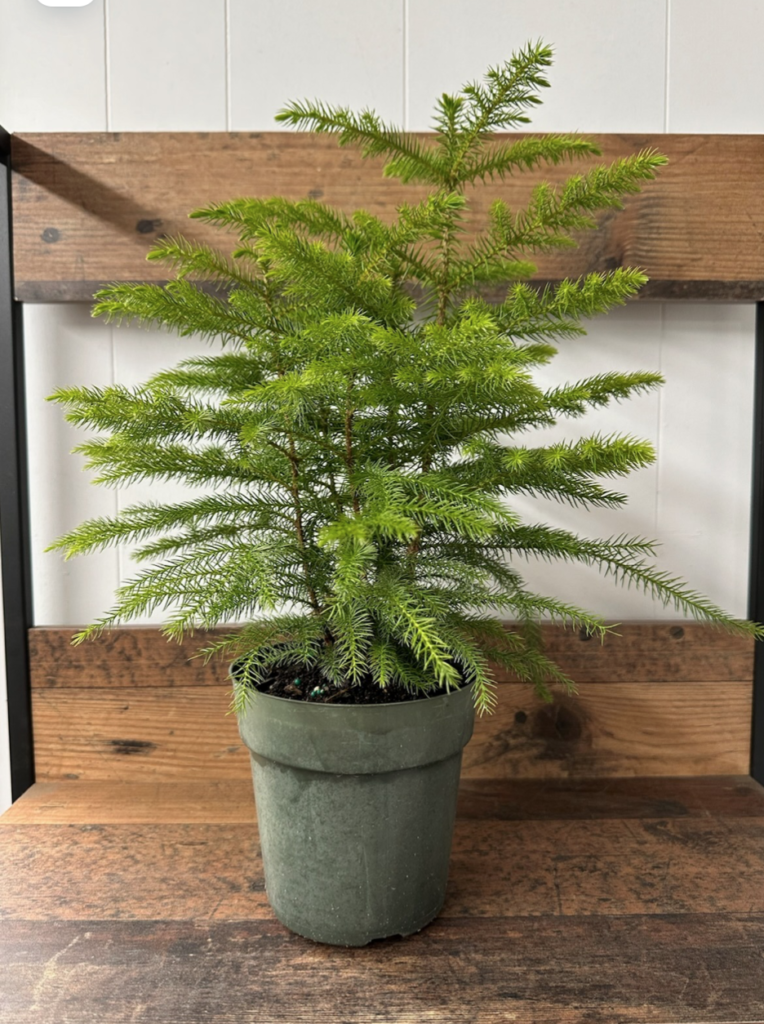
We offer Norfolk pine trees in 4″, 6″, 8″, 10″, and 14″.
Norfolk pines (Araucaria heterophylla) are unique trees native to Norfolk Island, which is situated in the South Pacific Ocean between New Zealand and New Caledonia. Here’s a rundown of what makes them special:
Appearance: Norfolk pines are evergreen conifers that have a distinctive, symmetrical shape. They can grow quite tall, reaching heights of up to 200 feet in their natural habitat. They have a pyramidal form with whorled branches that give them a feathery, fern-like appearance.
Leaves: The leaves are needle-like and arranged in a spiral around the branches. They are soft and flexible, contrasting with the sharp, rigid needles of some other conifers.
Growth: These trees are slow-growing, particularly in non-native environments. In cooler climates, they are often grown as ornamental indoor plants or as landscape trees in warmer regions.
Climate: Norfolk pines prefer a tropical to subtropical climate, thriving in warm, humid conditions. They are not frost-tolerant and generally do not survive in temperatures below freezing.
Caring for a Norfolk pine as a houseplant involves providing the right conditions to mimic its natural tropical environment.
Here are some key tips for keeping your Norfolk pine healthy and thriving indoors:
Light
Bright, Indirect Light: Norfolk pines prefer bright, indirect light. Direct sunlight can scorch the leaves, so place the plant near a window with filtered light or in a well-lit room.
Avoid Low Light: They do not do well in low light conditions. If light levels are insufficient, the tree may become leggy or lose its lower branches.
Temperature
Warm Temperatures: Keep the temperature between 65-75°F. Norfolk pines are sensitive to temperature fluctuations and do not tolerate cold drafts.
Avoid Cold Spots: Keep the plant away from cold drafts, air conditioners, or heaters.
Humidity
High Humidity: Norfolk pines thrive in higher humidity. If your home is dry, consider using a humidifier or placing the plant on a humidity tray with pebbles and water.
Misting: Lightly misting the plant occasionally can also help increase humidity around the foliage.
Watering
Consistent Moisture: Keep the soil consistently moist but not waterlogged. Allow the top inch of soil to dry out before watering again.
Avoid Overwatering: Make sure the pot has good drainage to prevent root rot, which can be a problem if the plant sits in soggy soil.
Soil
Well-Draining Soil: Use a well-draining potting mix. A mix designed for houseplants or a blend of peat, pine bark, and perlite works well.
Repotting: Repot the tree every 2-3 years or when it outgrows its current container. Choose a pot that’s only slightly larger than the current one to avoid excess moisture around the roots.
Fertilizing
Balanced Fertilizer: Feed the plant with a balanced, water-soluble fertilizer (e.g., 10-10-10) every 4-6 weeks during the growing season (spring and summer). Reduce feeding in fall and winter.
Pruning
Light Pruning: Minimal pruning is usually required. Remove any dead or damaged branches to maintain the plant’s appearance. Prune sparingly to avoid stressing the plant.
Pests and Problems
Check for Pests: Keep an eye out for common houseplant pests such as spider mites, scale, or aphids. Treat infestations promptly with insecticidal soap or neem oil.
Watch for Problems: Yellowing needles can indicate overwatering or poor light conditions. Adjust care as needed based on the plant’s response.
By replicating the Norfolk pine’s natural conditions as closely as possible, you can keep your houseplant healthy and looking its best. If you have any questions about Norfolk pines or are interested in purchasing, feel free to email us, come by our nursery, or give us a call at (352)735-8350.
